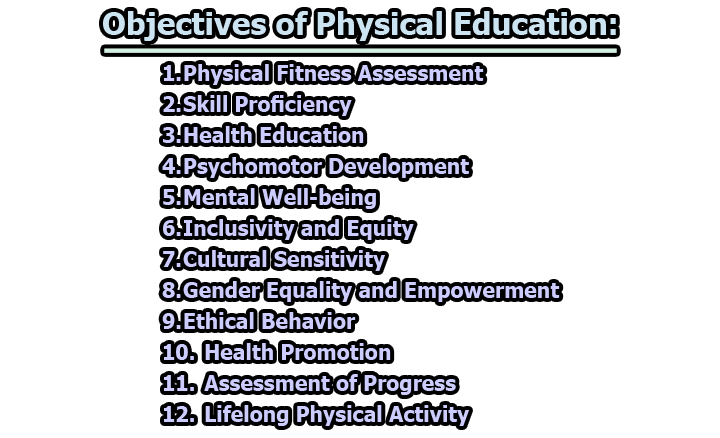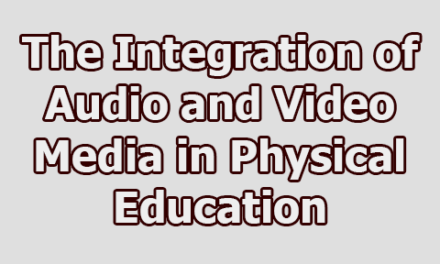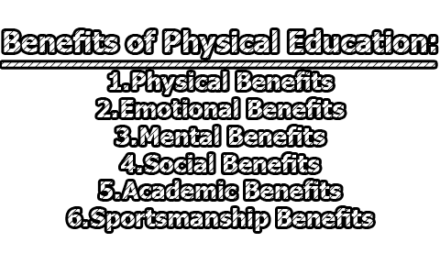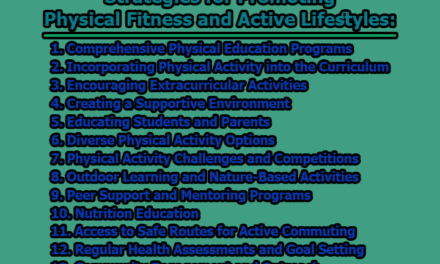Aims and Objectives of Physical Education:
Physical education (PE) is a cornerstone of the educational system, designed to foster the holistic development of individuals. It encompasses physical, mental, and social dimensions, aiming to create well-rounded individuals who contribute to a healthier and more active society. In the rest of this article, we will explore the aims and objectives of physical education.
Aims of Physical Education:
Physical Education (PE) is a vital component of the educational curriculum, with a set of well-defined aims designed to enrich the lives of students in multiple dimensions. These aims encompass not only physical health but also mental, social, and emotional aspects. Here, we will delve into the aims of physical education.
1. Promoting Physical Fitness: At the core of physical education is the aim to promote physical fitness. Regular physical activity, such as aerobic exercises, strength training, and flexibility routines, helps improve cardiovascular endurance, muscular strength, and flexibility (CDC, 2021). These activities are instrumental in maintaining and enhancing physical well-being.
2. Skill Development: PE aims to foster skill development in various sports and physical activities. These skills range from fundamental motor skills like running and jumping to more complex skills like those required for team sports (Sallis et al., 2012). Skill development encourages mastery and competence in various physical activities, contributing to lifelong participation.
3. Health Education: Another fundamental aim of physical education is to impart health education. Students are educated about the principles of a healthy lifestyle, including nutrition, hygiene, and the effects of a sedentary lifestyle (CDC, 2021). This knowledge empowers them to make informed decisions about their health and well-being.
4. Stress Reduction: Engaging in physical activities has been shown to reduce stress and anxiety. Regular exercise stimulates the release of endorphins, which act as natural mood elevators (AAHPERD, 2013). Thus, physical education plays a crucial role in promoting mental well-being and reducing the risk of conditions like depression.
5. Promoting Lifelong Physical Activity: Physical education aims to instill the habit of lifelong physical activity. It encourages students to view exercise not as a chore but as an integral part of a healthy lifestyle (CDC, 2021). By fostering a love for physical activity, it ensures individuals continue to prioritize their health throughout their lives.
6. Social Development: PE plays a significant role in social development. Through activities like team sports, students learn valuable social skills such as teamwork, communication, and cooperation (Sallis et al., 2012). These skills are transferable to various aspects of life and contribute to the development of well-rounded individuals.
7. Cultural Awareness: PE exposes students to a wide range of sports and physical activities from different cultures. This not only broadens their horizons but also promotes cultural awareness and tolerance (AAHPERD, 2013). Students gain a better understanding of diversity through exposure to various cultural practices in physical activities.
8. Gender Equality: An important aim of physical education is to break down gender stereotypes and promote gender equality in sports and physical activities. It encourages girls and boys to participate in all activities, challenging traditional norms and fostering inclusivity (CDC, 2021).
9. Ethical Values: Through sports and physical activities, physical education instills ethical values such as fairness, respect, and honesty (CDC, 2021). Students learn the importance of playing by the rules and exhibiting good sportsmanship.
10. Prevention of Lifestyle-Related Diseases: Physical education contributes to the prevention of lifestyle-related diseases like obesity, diabetes, and heart disease (World Health Organization, 2018). By promoting physical activity and healthy habits, it addresses risk factors associated with these conditions.
Objectives of Physical Education:
Physical Education (PE) programs are designed with specific objectives aimed at enhancing various aspects of an individual’s physical, mental, and social development. These objectives are crucial in guiding the curriculum and teaching methods within the discipline. Here, we explore the primary objectives of physical education:
1. Physical Fitness Assessment: Physical education programs prioritize the assessment of students’ physical fitness levels. This assessment includes measurements of cardiovascular endurance, muscular strength, flexibility, and body composition (CDC, 2021). These assessments are conducted periodically to monitor individual progress and identify areas for improvement. They provide a baseline for setting fitness goals and tracking changes over time.
2. Skill Proficiency: A fundamental objective of physical education is the development of physical skills. This includes not only basic motor skills like running, jumping, and throwing but also more specialized skills required for specific sports and activities (Sallis et al., 2012). For example, students may work on dribbling skills in basketball or swimming strokes in aquatic activities. The goal is to equip students with the competence and confidence to engage in various physical activities throughout their lives.
3. Health Education: PE programs incorporate health education as a core component. Students are taught about the principles of a healthy lifestyle, including the importance of balanced nutrition, regular exercise, proper hygiene, and the dangers of unhealthy behaviors such as smoking and substance abuse (CDC, 2021). This knowledge empowers students to make informed decisions about their health and well-being, setting the foundation for a healthy lifestyle.
4. Psychomotor Development: Physical education aims to enhance psychomotor development, which encompasses both fine and gross motor skills. Activities such as yoga, dance, and martial arts help students improve fine motor skills, while activities like running, jumping, and throwing enhance gross motor skills (Sallis et al., 2012). Developing these skills contributes to overall physical coordination and control.
5. Mental Well-being: In addition to physical health, PE objectives extend to mental well-being. Physical activity has been shown to have a positive impact on mental health by reducing stress and anxiety and promoting a sense of well-being (AAHPERD, 2013). PE programs often incorporate relaxation techniques, mindfulness exercises, and stress-reduction strategies to help students manage the challenges of daily life.
6. Inclusivity and Equity: An important objective in modern physical education is inclusivity and equity. PE programs should be designed to accommodate students with diverse needs and abilities (CDC, 2021). This includes providing adaptations and modifications for students with disabilities to ensure their full participation. The objective is to create an inclusive environment where every student can engage in physical activities to the best of their abilities.
7. Cultural Sensitivity: PE objectives also emphasize cultural sensitivity. Students are exposed to a variety of sports and physical activities from different cultures (AAHPERD, 2013). This exposure not only promotes cultural awareness but also fosters an appreciation for the diversity of movement practices around the world. It helps break down cultural barriers and encourages respect for different traditions.
8. Gender Equality and Empowerment: Physical education aims to promote gender equality by encouraging both girls and boys to participate in all activities, challenging traditional gender norms (CDC, 2021). This empowers students to pursue their interests and passions in sports and physical activities regardless of gender. It also promotes inclusivity and equal opportunities for all.
9. Ethical Behavior: Ethical behavior is a core objective in physical education. Students are taught the importance of fair play, respect for opponents, adherence to rules, and good sportsmanship (CDC, 2021). These values are instilled through participation in sports and physical activities and extend to life beyond the gym or playing field.
10. Health Promotion: The overarching objective of health promotion in PE is to improve overall health and well-being. This includes reducing the prevalence of lifestyle-related diseases such as obesity, diabetes, and heart disease (World Health Organization, 2018). PE programs aim to increase physical activity levels, improve cardiovascular fitness, and enhance overall fitness among students.
11. Assessment of Progress: Regular assessment of students’ physical fitness, skill development, and understanding of health-related concepts is an integral part of physical education (CDC, 2021). These assessments help educators tailor instruction to meet individual needs and track progress toward achieving specific objectives.
12. Lifelong Physical Activity: Perhaps one of the most critical objectives of physical education is to instill a love for lifelong physical activity. The objective is for students to develop a lasting commitment to physical fitness and well-being (CDC, 2021). By fostering a positive relationship with physical activity, PE aims to ensure that students continue to prioritize their health throughout their lives.
In conclusion, physical education is a vital component of education that contributes to the overall development of individuals. Its aims and objectives encompass physical fitness, skill development, health education, stress reduction, and the promotion of ethical values and social development. By imparting these essential life skills, physical education equips individuals to lead healthy, active, and fulfilling lives. It is an integral part of the educational system, contributing to the overall well-being of individuals and society as a whole. To maximize its impact, continued support and prioritization of physical education by educators, policymakers, and communities are essential.
References:
- CDC (Centers for Disease Control and Prevention). (2021). “Physical Education Curriculum Analysis Tool.” Retrieved from https://www.cdc.gov/healthyschools/pecat/index.htm
- Sallis, J. F., McKenzie, T. L., & Beets, M. W. (2012). “Physical education’s role in public health: Steps forward and backward over 20 years and HOPE for the future.” Research Quarterly for Exercise and Sport, 83(2), 125-135.
- American Alliance for Health, Physical Education, Recreation and Dance (AAHPERD). (2013). “Physical Education is Critical to Educating the Whole Child.”
- World Health Organization (WHO). (2018). “Physical Activity and Young People.”

Library Lecturer at Nurul Amin Degree College










